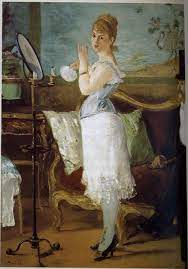
What is the male gaze?
‘In feminist theory, the male gaze is the act of depicting women and the world in the visual arts and in literature from a masculine, heterosexual perspective that presents and represents women as sexual objects for the pleasure of the heterosexual male viewer.’
Typically, the male gaze has been women presented through art created my men, for men’s use. It invokes the sexual politics of thee gaze, suggesting a sexualised way of looking at women. It empowers men whilst objectifying women. The female is usually positioned as an “object” of heterosexual male desire. Her own feelings are supressed by the male desire.
Laura Mulvey created the idea of feminist film theory, the concept of the male gaze in the film industry in her 1975 essay ‘Visual Pleasure and Narrative Cinema’. Mulvey, adopting the language of psychoanalysis, argued that the traditional Hollywood films respond to a drive known as “scopophilia”. Its the sexual pleasure involving looking. Mulvey believed that a lot of the popular movies are filmed to satisfy the masculine scopophilia. Instead of using the common term of the ‘male gaze’. Mulvey calls the concept a heterosexual, masculine gaze. She stated that women are typically characterised by their “to-be-looked-at-ness” in cinema. Woman is “spectacle”, and man is “the bearer of the look”. The Postman Always rings Twice is an example of the male gaze because the films lead female character is viewed through close-up shots of her body.

The male gaze in art history is understanding the preferences of a heterosexual male. The relevance of the male gaze in art history became relevant in the. For art history specifically, the idea of the male gaze is referencing the desire of men to create idealized images of women for their enjoyment. Also, this does not mean a strictly sexual enjoyment, the male gaze is the idea that male artists, painted for a male audience. In the early Renaissance the theory proved itself when they realised that art could be something that was bought and sold. During this time the only people who had money were men, making it obvious that artists would paint works that appealed to their target audience.


This is seen in todays photography such as magazines and advertisement. My photoshoots contradict the male gaze as my images are taken from a female perspective with the concept of presenting women as strong and independent individuals, lost in todays society and stereotypes.
